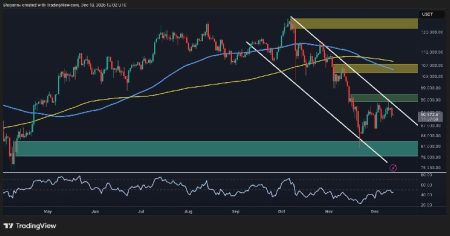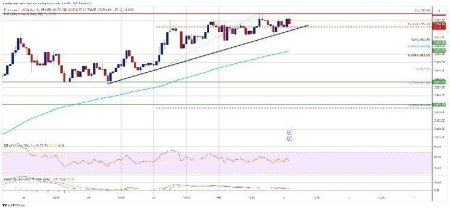Bitcoin Faces Potential Drop Below $100,000 After Triple Rejection at Critical Resistance
Market Recovery Follows “Black Friday” Crypto Crash, But Technical Signals Raise Concerns
In the wake of what traders are now dubbing “Black Friday” in cryptocurrency markets, Bitcoin (BTC) and other digital assets have begun showing signs of recovery. However, despite Bitcoin rebounding to approximately $114,000 and Ethereum (ETH) climbing back to $4,100, technical analysis suggests the leading cryptocurrency could still fall below the psychologically significant $100,000 threshold in the near future.
According to respected market analyst Omkar Godbole, Bitcoin’s recent price action reveals a concerning pattern that investors should monitor closely. As reported by Coindesk, Bitcoin has now failed three consecutive times to break through a key long-term trendline that connects the market peaks of 2017 and 2021. These repeated rejections at this critical resistance level are increasingly being viewed not as coincidental but as part of a broader technical pattern that could limit Bitcoin’s upward momentum in the current market cycle.
Technical Analysis Points to Weakening Momentum at Historic Resistance Zone
“Bitcoin has failed three times to break above the long-term trend line connecting the 2017 and 2021 peaks, reaffirming a medium-term downtrend,” Godbole explained in his analysis. “This trendline is acting as a key resistance in the current bullish cycle and technically, three failures form a pattern.”
The significance of Friday’s crash extends beyond just a momentary price decline. It represents the third instance where bulls have attempted but failed to sustain momentum above this crucial trend line drawn from previous bull market peaks. Each rejection at this level strengthens its significance as a resistance zone and increases the probability of a deeper market correction potentially taking Bitcoin below $100,000.
Technical indicators are providing additional evidence for caution. Throughout July, August, and October, Bitcoin formed what analysts call “long-wick candles” on monthly charts—a formation typically indicating a significant loss of upward momentum. Furthermore, the monthly Moving Average Convergence Divergence (MACD) histogram, a popular momentum indicator, remains in positive territory but at noticeably lower levels than during the December-January rally earlier this year.
Warning Signs Mount as Key Support Levels Come Into Focus
“The MACD histogram also remains in positive territory, but at a lower level than in the December-January rally, suggesting weakening upward momentum,” Godbole noted in his analysis. This technical deterioration around the historical trend line is particularly concerning after Bitcoin’s third failed attempt to hold above this level, making this resistance zone a critical battleground for the remainder of this market cycle.
Should the downward pressure continue, traders are now watching key support levels that could either halt the decline or accelerate it. The primary support level identified by analysts is the 200-day simple moving average (SMA), currently positioned around $107,000. This widely-followed technical indicator often serves as a dividing line between bull and bear markets. A decisive break below this level would significantly increase the likelihood of Bitcoin dropping below the $100,000 mark—a move that could trigger additional selling pressure from both retail investors and larger institutional players.
For those looking for signs of a potential reversal to the upside, Godbole has identified $121,800 as the critical level Bitcoin needs to break above to confirm a resumption of its uptrend. “Bitcoin clearly needs to break above $121,800 to enter an uptrend,” the analyst emphasized, providing a clear target for bulls attempting to regain control of market momentum.
Market Context: Understanding the Recent Volatility
The current market dynamics must be viewed within the broader context of Bitcoin’s price action in 2023 and 2024. After reaching new all-time highs earlier this year, Bitcoin has experienced increasing volatility while struggling to maintain consistent upward momentum. Friday’s sharp decline, which triggered the “Black Friday” moniker in crypto circles, represents one of the more significant pullbacks in recent months.
This volatility comes amid changing macroeconomic conditions, evolving regulatory frameworks, and shifting institutional sentiment toward cryptocurrency assets. While institutional adoption continues to grow through vehicles like spot Bitcoin ETFs, the market remains susceptible to technical resistance levels and profit-taking after substantial rallies.
Traders and investors should remember that cryptocurrency markets are notoriously volatile and that technical analysis provides probabilities rather than certainties. While the triple rejection at the long-term trendline presents a concerning pattern, market conditions can change rapidly based on fundamental developments, institutional flows, or shifts in market sentiment.
Navigating the Path Forward in an Uncertain Market
As Bitcoin navigates this critical technical juncture, market participants are advised to exercise caution and implement appropriate risk management strategies. The struggle between bulls and bears at these significant price levels often determines the medium-term direction of the market, making the coming weeks particularly important for Bitcoin’s price trajectory.
For long-term investors, these market fluctuations represent normal volatility in an asset class still maturing. However, for active traders, the current technical setup presents both risks and opportunities as Bitcoin tests critical support and resistance levels.
As always in cryptocurrency markets, diversification, position sizing, and a clear understanding of personal risk tolerance remain essential components of any investment strategy. While technical analysis provides valuable insights into market structure and potential price movements, it’s important to remember that past patterns don’t guarantee future results.
It’s worth emphasizing that this analysis does not constitute investment advice, and individuals should conduct their own research and consult with financial professionals before making investment decisions in this highly volatile market environment.















